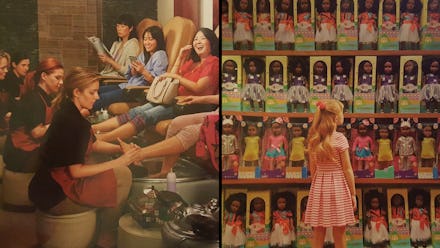These three pictures make a powerful statement about race and power among women

It can be difficult to understand how important representation is — until we are faced with a reversed gaze. O, the Oprah Magazine did just that for a photo essay featured in the publication's May 2017 issue on race.
In a feature aptly titled "Let's Talk About Race," photographer Chris Buck took three photos that flipped stereotypical tropes on their heads by reversing roles typically held by women of color with white women — and vice versa.
In one photo, Asian women are at a nail salon having their pedicures done by white women while chatting and laughing.
Another photo is of a young white girl looking up at shelves upon shelves of black dolls.
In the final photo of the series, a young Latina woman is seen sitting in a lavish chair at a luxurious apartment holding a Yorkshire Terrier while a white maid is pouring her a cup of tea. The young woman is also on the phone and not even acknowledging the presence of the maid.
It's been said that photos are worth a thousand words, and these three photos depict a complex conversation about race, class and power among women. Buck said there are a number of interpretations to the photos.
For the photographer, the baseline intention of the project was to bend race expectations. "When you see an image of someone from a different background, what is your expectation of them?" Buck asked rhetorically over the phone. "When you see an image from someone [of a different race], what is your expectation of them and are we challenging it? Why do we expect a certain thing from someone of a [certain race] and expect them to be serving another [race]?"
Although the creator of the series, Buck said he didn't come up with the concept behind the photos. Lucy Kaylin, editor-in-chief at O, the Oprah Magazine, curated the feature, and the publication's creative and editorial department commissioned Buck as the photographer of the piece. Kaylin said the main impetus behind the feature was to encourage an honest and passionate dialogue about race. She said the main concept of the feature came out of an ideation meeting with Oprah Winfrey herself.
"It was a topic on all of our minds and [Winfrey] was eager for us to tackle it," Kaylin said in an email. "The main thing we wanted to do was deal with the elephant in the room—that race is a thorny issue in our culture, and tensions are on the rise. So let's do our part to get an honest, compassionate conversation going, in which people feel heard and we all learn something—especially how we can all do better and move forward."
Buck, a white male photographer, said he didn't find it easy when he was commissioned to do the piece. As a white person, Buck said he is often in his own prism or world so it was rewarding for him to contextualize and see how people of different races perceive the world differently.
Buck said he believes it's essential to his job as a photographer to engage in conversations about race and social justice. He believes part of the reason why the feature was successful is that it was delivered with a light touch rather than a finger-pointing or "bossy" attitude.
"As a photographer in the U.S., for me to not be engaged in these issues would be a blind spot," Buck said over the phone. "It's important for me to be involved in stories like this, and help them become more nuanced and interesting. This is my job."
Buck's photos seem to have resonated with a lot of social media users — particularly women of color. Judy Gerlade, 21, is one of many who was moved by the feature. On Sunday, the Filipina-Chinese American posted these photos on Twitter and her tweet went viral .
In an email, Geralde said these photos reflect the internal struggles she endured due to the lack of representation of Asian women, as well as, the "overbearing whiteness" in her own childhood.
"It was incredibly difficult to feel like I had my own sense of belonging," Geralde said. "White seemed to be 'normal' from going to school and being one of the very few Asian Americans there, to seeing what was on the television screen — overbearing whiteness," she said.
Growing up, Geralde only had one Asian doll and it was Mulan. All the other dolls were white. So, even as a young child beyond the ability to comprehend race theory, Geralde knew she desired to relate to something or someone. "I realize that even as a child I was craving for someone to look like me, to be similar to me — something or someone to relate to," Geralde added.
Geralde isn't alone in her sentiment. Several other Twitter users expressed how powerful those pictures were to them.
Unfortunately, some social media users have gone so far as to accuse these photos of perpetuating "reverse-racism" or placing blame on white people for the status of certain women of color. Here are a few examples.
Buck, a white man, is unfazed by the online critics. He said that people's concerns and criticisms are valid, but said people who are overly sensitive (or easily offended) from all sides of all aisles have to "relax a little bit." Buck said he hopes conversations about these photos extend far beyond the virtual world and takes place in real life.
"If someone's feelings are hurt, and this is like pointing a finger at them, then great, let's talk about it," Buck said. "If this begins a conversation, then that's great – that's my take on it. It's fine if [the conversation] begins online, but more importantly, they should be carried out in the real world."